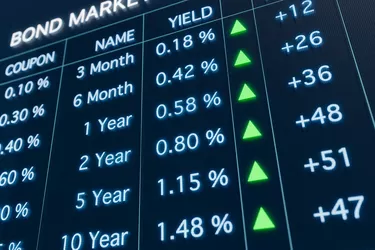
With the Federal Reserve Bank keeping interest rates abnormally low for the past several years, savers have had a difficult time finding decent returns for their savings accounts. Now with inflation at its highest in decades and stressing personal finances, the search has become more difficult.
However, the U.S. Treasury Department has a product that is extremely attractive for this economic environment. Series I savings bonds are now offering composite interest rate returns that are substantially above the market to offset the high inflation rate.
Video of the Day
Video of the Day
Here's how I Bonds work and how you can buy them.
What Are I Bonds?
Series I savings bonds are long-term investments backed by the U.S. government and are virtually risk-free. They are specifically designed to protect investors against the ravages of inflation.
Interest rates on I Bonds have two parts. They start with a fixed annual rate but add a variable rate based on changes in the Consumer Price Index (CPI). The variable part of the rate is adjusted every six months based on changes in the inflation rate as measured by the CPI and the fixed rate set by the Treasury. Because of the recent high inflation rates, I Bonds are now paying a current rate of 9.62 percent for bonds purchased through October 2022.
Unlike other corporate and government bonds, I Bonds do not pay out interest income on a monthly or quarterly basis. Instead, the interest earned every month is added to the principal amount of the bond. Bond interest on the combined amount of principal plus accrued months of interest is compounded every six months. You will only receive the interest earned on an I Bond when you redeem it for cash.
Interest earned on I Bonds is exempt from state and local taxes. In addition, you do not pay federal income tax on accrued interest until you cash in the bond.
I Bonds have maturities of either 20 or 30 years, at the discretion of the investor.
Series I Savings Bonds provide excellent returns to offset the high rate of inflation.
How to Buy I Bonds
You can purchase I Bonds either directly with the U.S. Treasury or by using the refund from your federal income tax return. You cannot purchase I Bonds through a brokerage account on the secondary market.
To purchase I Bonds through the Treasury, you must go to their website, TreasuryDirect.gov, and set up an account number. Everything is handled electronically and you do not receive physical paper certificates for your bonds. All your transactions are registered with your TreasuryDirect account
When you purchase electronic bonds directly with the treasury, you can purchase any amount down to the exact penny. For example, you could purchase a bond in the amount of $3,167.82 or $235.40 if you want to. The minimum purchase is $25.
If you are receiving a refund from your federal tax return, you can direct the IRS to issue I Bonds in your name instead of getting a cash refund. In this case, you will receive paper certificates for your bonds. Paper I Bond purchases are issued in denominations of $50, $100, $200, $500 and $1,000.
Maximum Purchase Amounts
You can only purchase a maximum of $10,000 per calendar year when buying I Bonds electronically through the TreasuryDirect website. Purchases made using a federal income tax refund are limited to $5,000 per calendar year. These maximum limits are for each method of purchase, which means that an individual could purchase under one Social Security Number a total of $15,000 per calendar year with both methods.
However, families could purchase higher amounts by using each member's individual Social Security Number or taxpayer identification number.